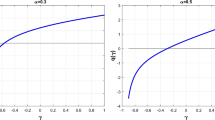Abstract
In this paper we show the characterization of the fractional powers of a class of positive operators by Chebyshev polynomials of the second kind. We consider the following higher order abstract Cauchy problems
with initial conditions given by
where X be a separable Hilbert space and \(A:D(A)\subset X\rightarrow X\) is an unbounded linear, closed, densely defined, self-adjoint and positive definite operator, and its fractional counterpart. Here, \(X^\alpha \) (\(0\leqslant \alpha \leqslant 1\)) denotes the domain of the fractional powers \(A^\alpha \) endowed with graphic norm.








Similar content being viewed by others
References
Abramowitz, M., Stegun, C.A. (eds.): Orthogonal polynomials. Ch. 22 in handbook of mathematical functions with formulas. Graphs Math. Tables 9, 771–802 (1972)
Amann, H.: Linear and Quasilinear Parabolic Problems. Volume I: Abstract Linear Theory. Birkhäuser Verlag, Basel (1995)
Balakrishnan, A.V.: Fractional powers of closed operators and the semigroups generated by them. Pac. J. Math. 10(2), 419–437 (1960)
Bezerra, F.D.M., Carvalho, A.N., Cholewa, J., Nascimento, M.J.D.: Parabolic approximation of damped wave equations via fractional powers: fast growing nonlinearities and continuity of the dynamics. J. Math. Anal. Appl. 450(1), 377–405 (2017)
Bezerra, F.D.M., Carvalho, A.N., Cholewa, J., Nascimento, M.J.D.: Fractional approximations of abstract semilinear parabolic problems. Discrete Contin. Dyn. Syst. B 25(11), 4221–4255 (2020)
Bezerra, F.D.M., Santos, L.A.: Fractional powers approach of operators for abstract evolution equations of third order in time. J. Differ. Equ. 269(7), 5661–5679 (2020)
Caixeta, A.H., Lasiecka, I., Cavalcanti, V.N.D.: Global attractors for a third order in time nonlinear dynamics. J. Differ. Equ. 261(1), 113–147 (2016)
Cholewa, J.W., Dłotko, T.: Global Attractors in Abstract Parabolic Problems, London Mathematical Society, Lecture Note Series, p. 278. Cambridge University Press, Cambridge (2000)
Fattorini, H.O.: The Cauchy Problem. Encyclopedia of Mathematics and its Applications, vol. 18. Addison-Wesley, Reading, MA (1983)
Henry, D.: Geometric Theory of Semilinear Parabolic Equations. Lecture Notes in Mathematics 840. Springer, Berlin (1981)
Kaltenbacher, B., Lasiecka, I., Marchand, R.: Well-posedness and exponential decay rates for the Moore–Gibson–Thompson equation arising in high intensity ultrasound. Control Cybern. 40(4), 971–988 (2011)
Marchand, R., McDevitt, T., Triggiani, R.: An abstract semigroup approach to the third-order Moore–Gibson–Thompson partial differential equation arising in high-intensity ultrasound: structural decomposition, spectral analysis, exponential stability. Math. Methods Appl. Sci. 35(15), 1896–1929 (2012)
Martínez, C., Sanz, M.: Spectral mapping theorem for fractional powers in locally convex spaces. Ann. Sc. norm.super. Pisa Cl. di Sci., \({4}^{e}\) série, tome 24(4), 685–702 (1997)
Pazy, A.: Semigroup of Linear Operators and Applications to Partial Differential Equations. Springe, New York (1983)
Pellicer, M., Said-Houari, B.: Wellposedness and decay rates for the Cauchy problem of the Moore–Gibson–Thompson equation arising in high intensity ultrasound. Appl. Math. Optim. 1–32 (2017)
Pellicera, M., Solà-Morales, J.: Optimal scalar products in the Moore–Gibson–Thompson equation. Evol. Equ. Control Theory 8(1), 203–220 (2019)
Ziebur, A.D.: On determining the structure of \(A\) by analysing \(e^{At}\). SIAM Rev. 12(1), 98–102 (1970)
Acknowledgements
The authors would like to thank the anonymous referees for their comments and suggestions which greatly improved the work.
Funding
This work was supported by CNPq/Brazil (Grant number # 303039/2021-3).
Author information
Authors and Affiliations
Contributions
All authors contributed to the study conception and design.
Corresponding author
Ethics declarations
Conflict of interest
The author(s) declare(s) that there is no conflict of interest.
Additional information
Publisher's Note
Springer Nature remains neutral with regard to jurisdictional claims in published maps and institutional affiliations.
Flank D. M. Bezerra research partially supported by CNPq/Finance Code # 303039/2021-3, Brazil.
Rights and permissions
Springer Nature or its licensor (e.g. a society or other partner) holds exclusive rights to this article under a publishing agreement with the author(s) or other rightsholder(s); author self-archiving of the accepted manuscript version of this article is solely governed by the terms of such publishing agreement and applicable law.
About this article
Cite this article
Bezerra, F.D.M., Santos, L.A. Chebyshev polynomials for higher order differential equations and fractional powers. Math. Ann. 388, 675–702 (2024). https://doi.org/10.1007/s00208-022-02554-x
Received:
Revised:
Accepted:
Published:
Issue Date:
DOI: https://doi.org/10.1007/s00208-022-02554-x



